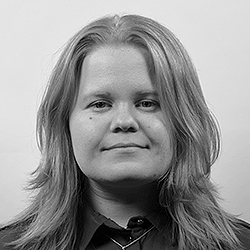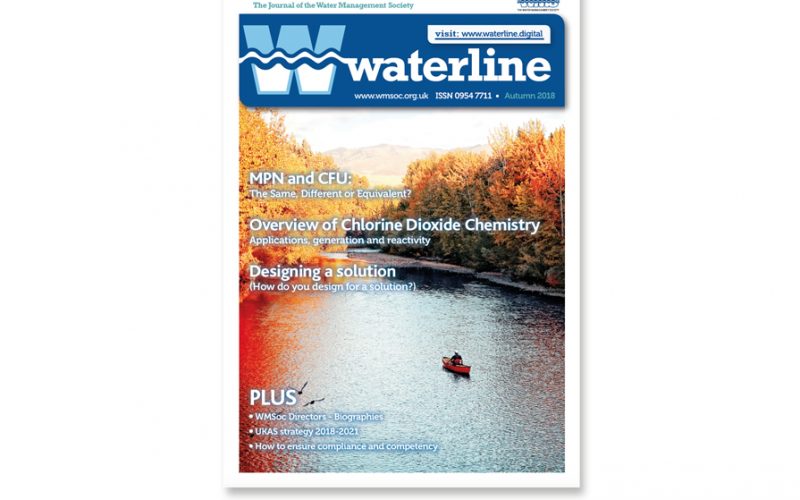As featured in waterline Autumn 2018
Designing a solution
(How do you design for a solution?)
– Rebecca Platt
WMSoc held a very successful “Designing Out” event in December 2017. In order to reach out and engage with architects and designers, we held a competition for design students. The winner was Becky Platt, from Sheffield Hallam University and she gave an engaging presentation regarding how she had researched the problem of safe water delivery and usage in a clinical setting. The aspect which really struck home with the delegates is that she had spoken to a wide variety of stakeholders and observed how they actually used taps and hand-washbasins. She then came up with some really novel new ideas to assist with good water hygiene. The article below explains her thought processes for developing the designs. We hope to hear more from her in the future regarding whether any of these have come to fruition.
“Design should not dominate things, should not dominate people. It should help people. That’s its role.” Dieter Rams
A quote that I believe couldn’t be any more true to what defines design.
I personally believe that Design should always have its primary focus on people. They are the users and influencers of what every design becomes. The solutions are for them, in which case the people should build the research and be the primary focus on how the design is resolved. They provide the design brief, dictate the piece created and provide the specifications that are needed, and without this balance of people and design, in my opinion, a resolved solution is difficult to achieve.
To create this balance and to design an effective solution, the design process needs to be followed so that every area is established. This process is typically split into 6 stages and these 6 stages are integral to providing a strong solution to the questions asked.
Broken into the
- • Analysis,
- Research,
- Definition,
- Development,
- Implementation and
- Reflection stages,
they are followed by every designer, no matter what skill or knowledge that they obtain and is a process that can be found within any type of decision making. Although it can be perceived as a step by step process, in my experience I have found that it is a continuous cycle as there is always a way to reflect and improve upon the decisions made.
Analysis
To create a range of effective solutions, it is of course crucial to follow the design process that would develop the ideas into resolved designs. This begins with analysis of the question that had been presented. The question asked, takes form into a design brief, this design brief is compiled of the requirements and wants of the client. Taking it apart and understanding the details of the brief is the ideal way to get on track to making an effective solution/answer. Establishing this analysis of the brief allows for the fundaments and specifications to be found for the design to follow. The brief and its details directs the theme of the research so it is important to gain a good understanding.
When approached by Jonathan Waggott, from the Water Management Society, he asked the question ‘How would you design out Healthcare Acquired Infections?’, specifically Legionnaires’ Disease [LD]. I was asked to produce a range of solutions that incorporated my experience as a young designer, to provide a new outlook on what could be created. Supplied with a short turnaround of 2 weeks and provided with a small amount of information, I was encouraged to create designs as diverse and open as they could be.
Research
Researching into how LD originated, spreads and caused a threat was established through secondary research. Exploring reliable internet sources and informative videos was a quick and definitive way to gain a clear understanding of a subject matter that was new to me. This research informed me of how LD is commonly found within cooling systems and poor pipe design. Spread further through warm temperatures of 37 – 45 degrees, designing out the disease would require looking into how it could be prevented through water based products/systems.
Although sourcing secondary research about LD and its prevention, establishes basic knowledge to create an idea, gaining informed knowledge from medical experts and professionals is a valuable insight that fully develops and grows the scope of the design. To gain this insight it was important to discuss LD with Jonathan Waggott, how it is spread and the specifications of what he was looking for within the designs. As an informed water specialist, Jonathan provided important details about LD and what he has previously gathered from his research. I was advised about LD and how it is also commonly spread through poor sink design and splash back. He explained how splash back can cause the spread of the disease by infected water getting onto nurses’ and doctors’ clothes whilst washing their hands.
Obtaining this direction guided me onto the next stage of research which was visiting local stores, through field research. Taking notes of materials and forms of sinks, taps and water-based products allowed further visualisation of what the market offered and a simple technique into coming up with new ideas. Further researching other products such as IPS panels and exploring the use of public sinks created a confident view of what sinks were utilised for and which areas could be further explored or improved upon. Gaining a visualisation of what products are out there and appreciating the current market, allows for a peek into what other designers have researched and what has proved to be successful.
With an established understanding of the subject matter of LD, sinks and the market, the next research stage was to gain the balance that the design would need by researching into the people behind the questions and the users of the solution. This research was undertaken by interviewing healthcare professionals and observing how they worked to prevent LD from spreading. Speaking with Dr Janet Wilson, a nursing professional at Sheffield Hallam University, she provided informative advice on strict handwashing techniques and the methods that nurses use to prevent infections from spreading across healthcare environments. Allowing for an expert to provide further advice on what could also be looked into, provides for a more in-depth analysis of the shape of the design. Hearing from experienced professionals is an invaluable source of information, as they are able to offer interesting insights that would not have been gained if basic secondary research was the only form of understanding.
With a large amount of research gained and a good amount of knowledge on the subject acquired, the definition stage can commence.
Definition
The definition stage is the stage in which all the ideas can be explored. Sketching, modelling and utilising 3D drawing software are a few of the methods that can be employed. The research is refined to create ideas that can provide an answer, and then transferred into a product or piece that can achieve the desired specifications. The early definition stage is a chance to produce implausible designs, designs that can be rapidly produced to present a wide variety of ideas that can be refined and developed further on.
Development
In order to provide a supportive and established solution, development has to be undertaken to fully flesh out the ideas into refined designs. This is supported by further research into the elective field. In my example, the primary ideas produced were: exploring the height and depth of sink designs; water directions and incorporating ultra-violet technology to analyse bacteria on ‘washed’ hands. Ideas that had potential but lacked the development that could be explored. To achieve this, observations into healthcare environments and the behaviour of other people in relation to sinks and handwashing were carried out to view any changes or improvements that could be made. From this, it was discovered how close others stood to the sinks whilst washing their hands, this would result in much of the water splash back getting onto their uniform and clothes. With the speed and efficiency medical staff achieve consistently throughout their active practice, they strive to provide the best care for their patients. Incorporating elements that can improve their care into the design would not only improve the efficiency of their work but prevent other infections from spreading.
Discovering the detail within this observation, truly developed the ideas to a variety of designs that contained a human centered focus. Obtaining a connection with the people and the design, fully forms how defined the design can become. Taking the time to look into how others use the products and design around this, offers a true insight into how designs can be improved and developed into a design that can help people. With this balance of people and design, the ideas would then be revised and improved into strong designs that could be implemented.
Implementation
The implementation stage is where the designs are converted into the real-life solutions that have been previously resolved, full scale modelling, testing and creating the 3D product/piece that the design intends to be. Crossing over with the development stage, this stage is a strenuous process in which every decision made is scrutinized and examined. Materials are tested, measurements revised and mechanisms studied to ensure the best solution is produced.
Reflection
The final stage of reflecting upon the choices and decisions made is an important step, as although a high amount of research, development and resolving has been undertaken throughout the process, no solution is perfect. Taking time to investigate how it can be improved if other aspects were different, such as time, cost or new technologies, allows for mistakes to be learnt and improvements to be implemented in the future. Although, I personally find that this stage is found throughout the design process, as every decision is questioned and critically evaluated, revising the choices made at the end allows for change in the future to be possible.
To conclude, designing a solution is an in depth analytical process in which every aspect of the design and topic is explored. Gaining insights from people and discovering unique methods, designers are problem solvers and decision makers. Their role is to analyse the situation, study the possibilities and provide an answer. With our world growing and consistently needing new developments, designers are a key part of the future of our growing society. I personally believe design has always been about improving the life we live and the world around us by providing new changes, alternatives and solutions to the current market, it has dictated our future and will continue to do so.

Rebecca Platt is a young furniture designer, currently studying at Sheffield Hallam University. Completing her final year of an MDES degree, Becky has focused on designing through various materials such as timber, metal and plaster, and has enjoyed utilising a range of manufacturing methods to extend her learning. She has been provided with a range of opportunities that have helped develop her confidence and knowledge within design, which she hopes to continue by pursuing a career into design making, journalism and/or teaching.












